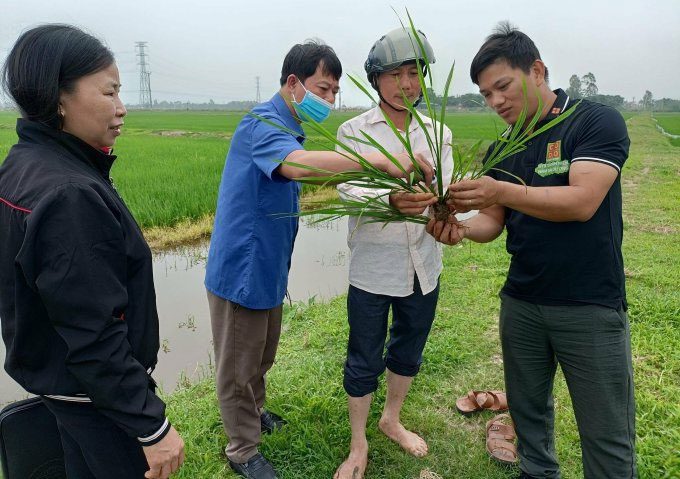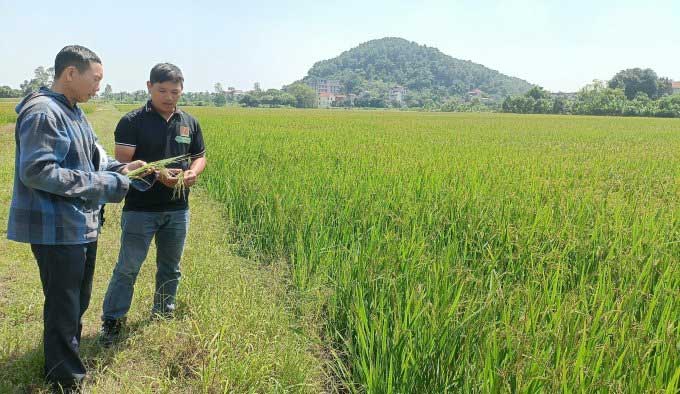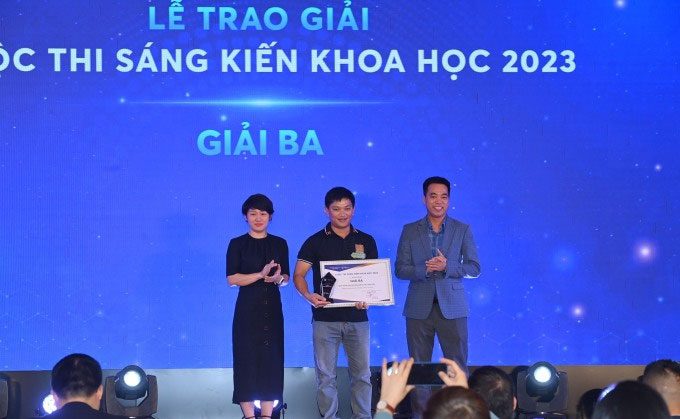The seed germination solution developed by Lương Văn Trường (34 years old) allows farmers to avoid soaking seeds, earning him third place in the 2023 Scientific Initiative Competition.
Born in Nam Định, a region closely associated with rice cultivation, engineer Lương Văn Trường aims to provide the most convenient seed production solution for local farmers. His solution involves offering ready-to-germinate seeds, enabling farmers to use the seeds easily without the risk of sprout breakage or decay that comes with traditional soaking methods.
By developing a technical process, Engineer Trường has helped bring germinated rice seeds into a dormant state to sustain their viability under adverse conditions, such as drought. The germinated seeds are stored until the right time for planting. After purchasing the seeds, farmers can sow them directly without soaking, and the seeds will revert to their germination state and grow as usual. Seeds treated with this method germinate very quickly, typically within 30 to 120 minutes under suitable conditions. This technological process was perfected in October 2020 and a patent was registered in 2021.
Reflecting on his entrepreneurial journey, Lương Văn Trường shares that he was born into a farming family in Nghĩa Trung Commune, Nghĩa Hưng District, Nam Định Province. As a child, with only 6 sao (0.6 hectares) of rice fields divided into distant plots, he dreamed of consolidating these small fields into a large, mechanized rice farm. With a passion for agriculture, he pursued a degree in post-harvest technology at Đà Lạt University. In 2011, after graduating, Trường participated in a national project for young vice chairmen and became the Vice Chairman of the People’s Committee in Lùng Thẩn Commune, Si Ma Cai District, Lào Cai Province, overseeing local agriculture and forestry from 2012 to 2016.

Lương Văn Trường (far right) discussing rice varieties with farmers. (Photo: NVCC)
After completing his duties, he returned to his hometown to establish his career by renting 7 hectares of agricultural land for rice cultivation. Starting large-scale production posed challenges; in the 2018 season, heavy rain for over twenty consecutive days forced him to discard all his seeds because they could not be sown, and the germinated seeds were hard to store and often spoiled after a few days. “I lost 4 to 5 tons of seeds, with total losses exceeding one billion VND for the season,” he recalled.
Seeing that many regions in the province faced similar challenges, Trường was determined to find ways to help farmers preserve seeds longer and manage planting more effectively. The idea of bringing germinated rice seeds into a dormant state originated from this experience.
According to Trường’s calculations, the industrial production process costs only about 2,000 VND/kg. In contrast, if farmers soak fresh seeds, the cost for 1 kg (including labor, materials, water, electricity, etc.) is at least 10,000 VND. Currently, Vietnam cultivates about 7 million hectares of rice, using around 700,000 tons of seeds each year. Implementing this process could save the domestic agriculture sector over 3 trillion VND and help save millions of labor hours each season.
The product is already widely used in Nam Định. He has also tested it in several other provinces such as Thái Bình and Bạc Liêu to evaluate the technology’s suitability for different production regions.
Trần Thị Tuần, Chairwoman of the Farmers’ Association in Chi Lăng Nam Commune, Thanh Miện District, Hải Dương Province, noted that the ready-to-germinate seed packets are very useful and convenient, eliminating the need for soaking and allowing farmers to plant at their convenience. This season, she ordered ST25, Bắc Thơm, and Hương Cốm seeds from the Thanh Niên Nam Đại Dương cooperative, which Trường manages, for over 1 mẫu (0.1 hectares) of land. Currently, the rice is growing beautifully and uniformly.
She mentioned conducting a comparison between the two types of seeds: the ready-to-germinate and the traditionally soaked ones. “Initially, I was a bit anxious, fearing the seeds wouldn’t sprout, but they turned out to be very vigorous, with a high germination rate,” she said. Tuần also introduced and guided some groups of farmers in the commune to use the seeds. She assesses Trường as a talented young man with a strong affinity for agriculture, who is diligent in exploring and innovating useful research.

Lương Văn Trường (in black) experimenting with farmers in a rice field in Minh Tân Commune, Vụ Bản District, Nam Định Province. (Photo: NCVV).
From a small farm, Trường and his colleagues established the Nam Đại Dương Youth Cooperative in early 2021, covering nearly 40 hectares. For his efforts and contributions, Lương Văn Trường received the Nam Định Provincial Award for Scientific Innovation in 2021, as well as the Lương Định Của Award for Outstanding Young Farmers. “I hope this technology will soon be widely used in both Vietnam and globally, helping farmers minimize risks and losses during natural disasters while increasing profits and making production easier,” Trường stated.
In an interview, Trần Huy Quang, Deputy Director of the Nam Định Department of Science and Technology, praised Lương Văn Trường’s initiative, which enhances productivity and quality in production. His project has also received support from the Department in the research, testing, result evaluation, and branding process.
He added that Trường is one of the exemplary young figures active in sharing experiences and inspiring innovative entrepreneurship. “I hope that the recognition from the organizing committee and the judging panel for Lương Văn Trường will motivate and boost innovation activities in the province,” Quang said.

Author Lương Văn Trường (center) receiving the third prize for his ready-to-germinate seed project. (Photo: Giang Huy).
Lương Văn Trường’s solution has been recognized by the judging panel of the Scientific Initiative Competition for its significant impact on rice seed production, especially in a country where agriculture plays a dominant role. Scientists have also suggested that the author clarify the methods of changing and transforming the impacts on the germination process to optimize the technology.




















































